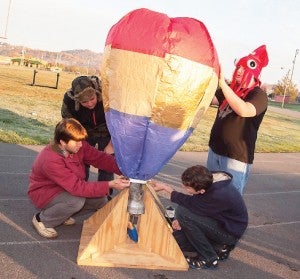EHS students send balloons up, up and away
Published 10:00 am Monday, November 3, 2014
Elizabethton High School students launched their latest science project into the heavens.
Nope, it wasn’t because they were frustrated with it. Gaining altitude was the whole point of the project.
On Friday morning, EHS students released balloons they had constructed to see how high and how far the inflatables would travel.
Students in Ann Graves’ physical science class and Dan Mill’s aviation science class worked together to make crepe paper balloons. The balloons were then heated and released into the sky to see how high and how far they would travel.
Students were broken into five teams. This week, the classes met together to build the balloons for the project. The balloons were made of 27-30 pieces of crepe paper that were rubber cemented together. The ends of the balloon were taped to seal it.
Brandon Cordell offered some advise for building crepe paper balloons.
“Check twice, glue once,” he said.
Mills said the project was a way for students to understand the science behind balloons while getting to experience it for themselves.
“It really is a neat process,” Mills said. “The students get the chance to work with science hands on.”
The students gathered outside the school to see if their balloons would hold air, and then how far the balloons would go after the air was heated. To heat the air, the balloons were held over a burner.
“Hot air inflates the balloon,” Mills said. “Depending on how good the balloon is will determine how high it goes. The wind determines where it goes.”
After the balloon is released, the atmosphere will cool the heated air and it will start to descend. Under favorable conditions, Mills said balloons could rise to 400-500 feet.
Student Kailee Buckles noted the cooler morning temperatures might help the balloons take off from the launch site.
“The colder it is, the denser the air so the balloon will fly higher,” Buckles said. “The hot air inside the balloon is less dense.”
While the chilly temperatures Friday morning might have been perfect conditions for the balloons to rise, the calm breezes may have hampered the balloons ability to travel.
“In past years, we have had a little more wind to carry the balloons a bit farther from the launch pad,” Graves said. “This year was nice cold weather but not the best for distance when balloons were launched.”
Not all balloon launches were successful though.
“Not all hot air rises if the balloon catches on fire,” Tristan Stresemann said.
The balloon project was part of a study on the history of hot air balloons and how they have been used.
“The project introduced the practical benefits of hot air balloons and the history of how they served communities for various reasons, weather studies, war time intelligence, leisure and possibly for studying scientific variables like air quality and different altitudes,” Graves explained.
The study also included the physics of why balloons fly and the chemistry behind those theories.
“During this project, we discussed molecular activity and the gas laws to describe the science behind hot air balloon flight and how it is possible,” Graves said.





